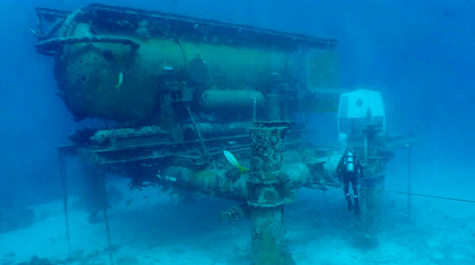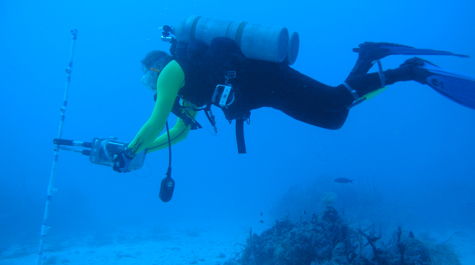Patterson helps prepare astronauts for future visit to asteroid
Professor Mark Patterson of the Virginia Institute of Marine Science, an aquanaut with several previous trips to “inner space” aboard the Aquarius underwater habitat, will assist a team of NASA astronauts as they visit the habitat between October 17 and 29 to develop techniques for a planned future trip to an asteroid.
Patterson is part of the science support team for NEEMO 15—the latest mission of the NASA Extreme Environment Mission Operations project. NEEMO sends groups of NASA astronauts and engineers to live in the Aquarius undersea research station as training for work in the weightlessness of outer space.
Patterson, Director of the Autonomous Systems Laboratory at VIMS, is a pioneer in the development and use of underwater robots for marine research. His role during the upcoming 13-day NEEMO mission will be to assist the aquanauts as they deploy and operate an oceanographic sensor that will be mounted atop a one-person DeepWorker submarine. Patterson will assist on the first five days of the mission.
“For the NEEMO 15 mission—the first in what will be many dress rehearsals for going to an asteroid—I’ll be flying an ocean profiler onDeepWorker,” says Patterson. The instrument—which Patterson has previously deployed on his autonomous underwater vehicle Fetch—measures ocean acidity, levels of dissolved oxygen and carbon dioxide, and water temperature.
“The astronauts will do marine science as practice for doing science in extreme environments with small teams,” says Patterson. “Previous NEEMO missions have focused on medicine and engineering. Now, to prepare for going to an asteroid, the astronauts will start learning how to conduct research in a near-zero-gravity environment.”
During the mission, Patterson will work with marine biologists George Schmahl and Emma Hickerson of NOAA’s Flower Garden Banks National Marine Sanctuary, who will each pilot a DeepWorker submarine. NASA’s goal is to have the manned submersibles act as “Space Exploration Vehicles” that will interact with aquanauts to test the most efficient methods for deploying instruments and collecting samples.
“The DeepWorker pilots will be doing flyovers in conjunction with the astronauts as they SCUBA dive around Aquarius,” says Patterson. “I’ll be topside on a support vessel, guiding the interaction and the science done with the DeepWorker while the astronauts are down there simulating a space walk.”
In addition to Schmahl and Hickerson, NASA astronauts Stan Love, Richard Arnold, and Mike Gernhardt will also pilot DeepWorker. All are veteran spacewalkers.
The NEEMO 15 mission’s international team is led by former Space Station crewmember Shannon Walker. The crew also includes Japanese astronaut Takuya Onishi, Canadian astronaut David Saint-Jacques, and Americans Steven Squyres, James Talacek, and Nate Bender. Squyres is the scientific principal investigator for the Mars Exploration Rover Project. Talacek and Bender are professional aquanauts.
VIMS alumnus Dr. Art Trembanis (Ph.D, 2004), now a faculty member at the University of Delaware, is also a member of the science support team for NEEMO 15. His role will be to interpret the video stream captured by DeepWorker’s high-definition cameras. Trembanis is a pioneer in the use of autonomous underwater vehicles (AUVs) to collect video data in extreme environments. The focus of his current work is use of the Gavia AUV to study the unique algal communities of Pavilion Lake in Canada.
Outreach
Patterson is hoping to make the DeepWorker video feed part of his outreach activities during the NEEMO 15 mission. Those activities include plans to Skype with the graduate students in his Ocean Observing course at VIMS, and to interact with students at Peasley Middle School in Gloucester. Patterson’s graduate student Jennifer Elliott is a GK-12 fellow who is currently teaching science in the local school.
The Aquarius underwater habitat is deployed three-and-a half miles off Key Largo, at a depth of 60 feet and adjacent to coral reefs in the Florida Keys National Marine Sanctuary. It is owned by the National Oceanic and Atmospheric Administration (NOAA) and operated by the University of North Carolina, Wilmington. NOAA Administrator Jane Lubchenco is scheduled to visit the Aquarius site during the NEEMO 15 mission.
 Skip to main content
Skip to main content


